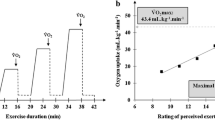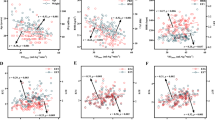Summary
Recent research has related pedalling frequency to perceived exertion, indicating that subjects pedalling at higher frequencies tend to perceive lower levels of exertion. If tests administered at higher pedalling speeds are valid, then more accurate data on extremely low fit individuals might be possible. The purpose of this study was to determine the validity of the Wahlund-Sjostrand W170 test administered at 50 and 80 rpm. Maximal oxygen intake was determined for thirty male volunteer college students using standard open-circuit techniques. W170 tests were administered at 50 and 80 rpm using standard test protocol. The results indicated a differential effect of pedalling speed upon the validity of the W170 tests. Validity coefficients of r xy=0.73 and r xy=0.64 were found for the 50 and 80 rpm tests, respectively. Maximal oxygen intake predicted from the W170 test administered at 80 rpm was significantly different from both the criterion maximal oxygen intake and the W170 prediction at 50 rpm. This difference was attributed to a significantly higher heart rate response to 80 rpm tests at the lower workload of 600 kpm/min. It was concluded that more valid W170 tests are attained at the conventional pedalling speed of 50 rpm.
Similar content being viewed by others
References
Banister, E. W., Jackson, R. C.: The effect of speed and load changes on oxygen uptake for equivalent power outputs during bicycle ergometry. Int. Z. angew. Physiol. 24, 284–290 (1967)
Benedict, W. E., Cathcart, P. H.: The effect of speed in relation to constant load and perceived exertion. Int. Z. angew. Physiol. 26, 39–45 (1969)
Borg, G., Dahlstrom, H.: The reliability and validity of a physical work test. Acta physiol. scand. 55, 353–361 (1962)
Eckermann, P., Millahn, H. P.: The influence of pedal frequency on heart rate and oxygen intake during constant performance on the bicycle ergometer. Int. Z. angew. Physiol. 23, 340–344 (1967)
Kamon, E., Metz, K., Pandolf, K.: The cost of climbing and cycling with additional weights around the waist and ankles. Paper presented at the Nineteenth Annual Meeting of the American College of Sports Medicine, Philadelphia 1972
Kay, J. D. S., Petersen, E. S., Vejby-Christensen, H.: Breathing in man during steady-state exercise on the bicycle at two pedalling frequencies, and during treadmill walking. J. Physiol. (Lond.) 251, 645–656 (1975)
Knuttgen, H. G., Petersen, F. B., Klausen, K.: Oxygen uptake and heart rate responses to exercise performed with concentric and eccentric muscle contractions. Med. Sci. Sports 3, 1–5 (1971)
Pandolf, K. B., Noble, B. J.: The effect of pedalling speed and resistance changes on perceived exertion for equivalent power outputs on the bicycle ergometer. Med. Sci. Sports 5, 132–136 (1973)
Sjostrand, T.: Changes in the respiratory organs of workmen at an ore smelting works. Acta med. scand. 196, 687–699 (1947)
Snyder, M. L.: Optimum pedal speeds and submaximal loads for bicycle powered machines. Unpublished master's thesis, University of Washington 1967
Stamford, B. A.: Perceptual and physiological responses to equivalent power outputs performed on a bicycle ergometer at varying pedalling rates. Unpublished doctoral dissertation, University of Pittsburg 1973
Ulmer, H. V.: The dependence of the performance feeling on pedalling frequency among sport cyclists. Sport u. Sportmed. 10, 385–390 (1969)
Wahlund, H.: Determination of physical working capacity. Acta med. scand. 215, 1–78 (1948)
Author information
Authors and Affiliations
Rights and permissions
About this article
Cite this article
Jessup, G.T. Validity of the W170 test for predicting maximal oxygen intake. Europ. J. Appl. Physiol. 37, 191–196 (1977). https://doi.org/10.1007/BF00421774
Accepted:
Issue Date:
DOI: https://doi.org/10.1007/BF00421774




